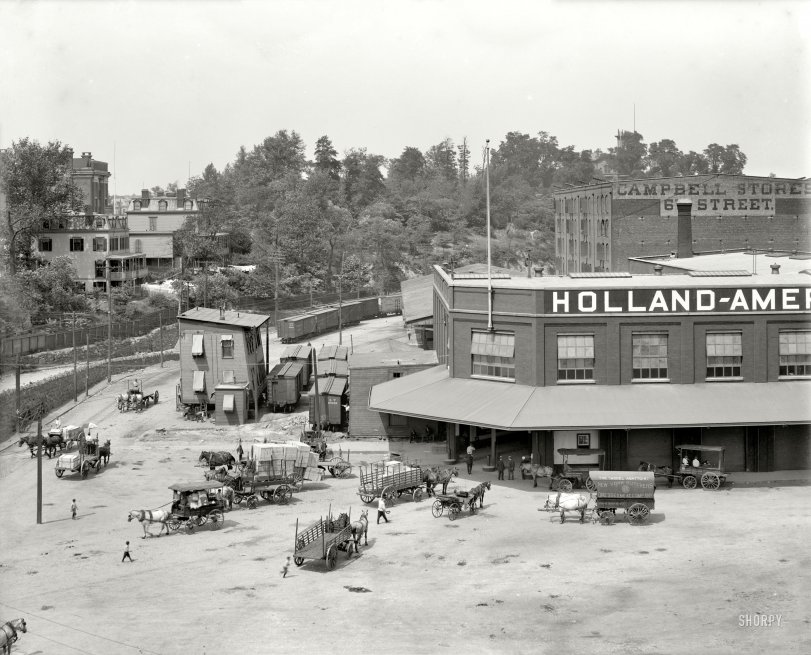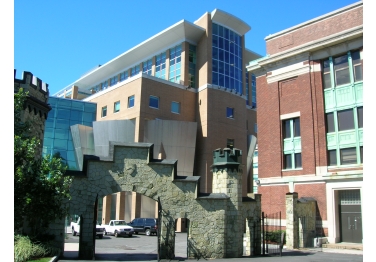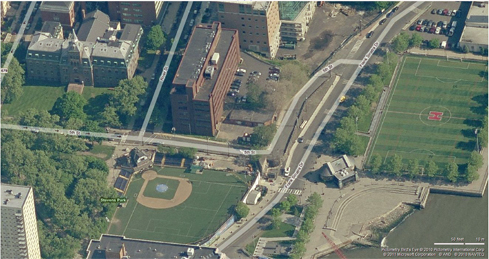


Framed or unframed, desk size to sofa size, printed by us in Arizona and Alabama since 2007. Explore now.
Shorpy is funded by you. Patreon contributors get an ad-free experience.
Learn more.

- Baldwin 62303
- Baldwin VO-1000
- Cold
- No expense spared
- Tough Guys
- Lost in Toyland
- And without gloves
- If I were a blindfolded time traveler
- Smoke Consumer Also Cooks
- Oh that stove!
- Possibly still there?
- What?!?
- $100 Reward
- Freeze Frame
- Texas Flyer wanted
- Just a Year Too Soon
- WWII -- Replacing men with women at the railroad crossing.
- Yes, Icing
- You kids drive me nuts!
- NOT An Easy Job
- I wonder
- Just add window boxes
- Icing Platform?
- Indiana Harbor Belt abides
- Freezing haze
- Corrections (for those who care)
- C&NW at Nelson
- Fallen Flags
- A dangerous job made worse
- Water Stop
Print Emporium
Working Horses of Hoboken: 1910

Hoboken, New Jersey, circa 1910. "Holland America docks." Lefthand section of a three-part panorama. There are, as we like to say, many interesting details here. 8x10 inch dry plate glass negative, Detroit Publishing Company. View full size.
Hoboken Shore RR
The "tipsy building" is the office of the Hoboken Shore RR, formerly Hoboken Manufacturers' RR. Those are the company's tracks, and the small building behind it right up next to the brick pier building is their freight house. In some of the other 1905 and 1908 photos looking east you can read the sign on it. Others have figured out that the tipsy building was a part of the older, wooden 5th Street pier structure. The RR must have bought just that bit and sawed it off and mounted it on the cribbing when the new one was built sometime between 1905 and 1908! I've seen a Hoboken phone book from the period that lists the HS RR office as being at "the foot of 5th Street."
Rock solid rock wall
A portion of the rock retaining wall shown on the left side of this photo still survives next to the sidewalk along Frank Sinatra Drive.
House on the Hill
The building behind the trees at top right is "Stevens Castle," home of Edwin Stevens, founder of Stevens Institute of Technology. It was torn down in 1959.
The boxcars and the wires
No technology existed in 1810 that would have called for hanging wires from poles, except, perhaps, a clothesline. I would also suggest that the wealth of stockade fences would have been prohibitively expensive before the advent of modern lumbermills after the Civil War; ditto the large plate glass windows. I won't go too deeply into a stylistic analysis of the mansard-roofed houses, but they are a Victorian style, not any of the styles that would have been seen in 1810. I lived in one in Connecticut in the early '90s that was very similar. I recently looked it up. Zillow says it was built in 1873.
The odd shaped building
I would guess that funny shaped building was once part of some other structure but was detached and moved for some reason.
Note the Orphaned "M" on the top left of it, part of it is cut off and the building seems to have had a new back attached.
The only surviving building
I can find is the one visible over the top of the house on the right. It's now part of Stevens Institute of Technology and may have been then. The other end of it is on the NE corner of 6th & River Streets.
The RR tracks in the pic run in about the same area that Frank Sinatra Drive does now.

Awnings and other period details
I believe awnings were important to block the sunlight on summer days to keep structures cool.
Architecturally, I'd date the Holland-American building itself as relatively recent, probably since the turn of that century. That's due to the large windows and the absence of a brick arched header (the headers are probably iron/steel beams.) Compare to the older Campbell Storage building that has more typical arched headers and smaller, round-topped windows. Also the Campbell building has a shallow sloped gable roof, vs the flat roof on Holland-American.
Edit: A later shot shows the Holland-American building also has a shallow sloped roof, but that's obscured by the architecture.
The fact that there's a small piece of a sign on that strange building on the left supports the idea this was a part of a structure moved here from elsewhere. What I don't understand is the sloped right-hand wall. I agree with Pdxrailtransit this could have been part of a wharf building. Seems I've seen sloped sides on such buildings, but I don't know why they were constructed that way.
In the back is a Merchants Dispatch Transportation reefer. If you look closely at the bottom of the car, you can see 3 stripes. On the Yahoo EarlyRail group, we had quite a discussion on the colors of those stripes, trying to understand/project how B&W films responds to different colors, contemporary advertising and paint/textual records.
All-in-all, a great shot, full of interesting details.
Dig those Mansard Roofs
The odd shaped building on the left looks like it was built somewhere else. Note that it rests on timber cribbing and not a foundation. My guess is that this building once rested on a wharf or pier. Similar structures can be seen in this Shorpy photo.
The awnings are awesome, it is amazing how much effort was put in to enhancing such a prosaic structure. Anyone living in the garrets of the two mansard roofed homes would have had quite a view of the daily comings and goings.
Re: Geometry
I'm not sure what the purpose of building the place like that was, tterrace, but it sure would have made hanging pictures on that back wall difficult. Note the awnings on that sloped wall, just beneath the overhanging roof.
Geometry
There must be a practical reason for the irregular shape of the building at the left, I know there must.
A lot of horsing around
Hopefully the white horses hauling the covered wagon don't know what "Abattoir" means!
5th Street
The Holland-America Line had a facility at the base of 5th Street in Hoboken. In the upper right above the Campbell Store sign in the photo, a structure can be seen behind the trees. In the satellite image below, on old school can be seen near 5th Street near the waterfront which resembles that structure. This may have been the location of the photograph.

Two HP
It's amazing what you can transport with two horsepower. We forget that these days, with our 300 HP four-wheel-drive grocery-getters.
























On Shorpy:
Today’s Top 5